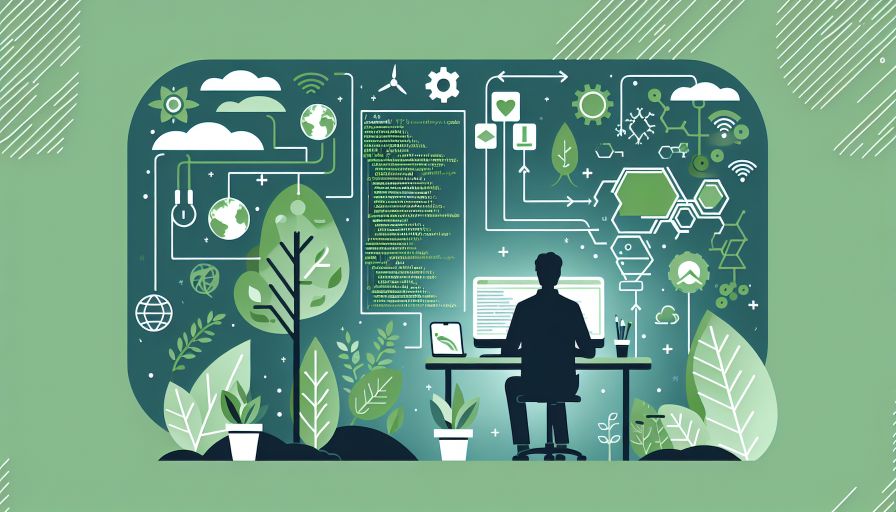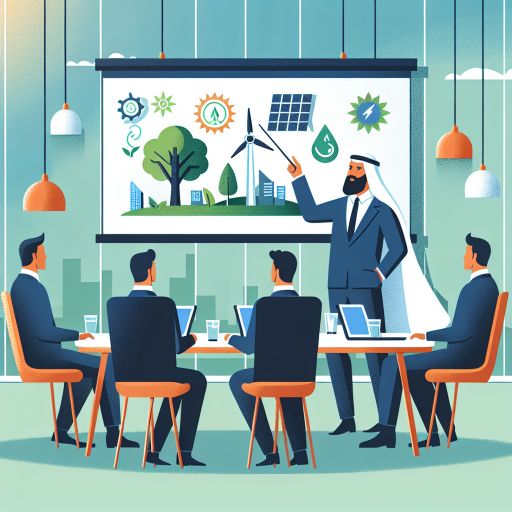Introduction to Sabir Khan and Sustainable Software Development Practices
Sabir Khan is a prominent figure in the realm of software development, renowned for his commitment to integrating sustainable practices within the tech industry. With a focus on Green IT principles, Khan has been instrumental in driving the adoption of environmentally responsible and resource-efficient technologies. His work addresses the environmental impact of IT infrastructure and operations, encompassing a wide range of strategies aimed at reducing energy consumption, minimizing e-waste, and optimizing software performance for sustainability.
Khan’s journey in the field of sustainable software development began with an acute awareness of the growing environmental impact of the tech industry. The increasing proliferation of data centers, the constant demand for new hardware, and the extensive use of energy-intensive processes have all contributed to a significant carbon footprint. Recognizing these challenges, Khan set out to develop and promote practices that would align the growing demands of technology with environmental stewardship.
Through his research and leadership, Sabir Khan has highlighted the importance of designing software that not only meets functional requirements but also prioritizes environmental sustainability. This involves creating applications that are optimized for energy efficiency, prolonging the lifecycle of hardware by reducing the need for frequent upgrades, and ensuring that software applications are compatible with a variety of energy-efficient devices.
Moreover, Khan has been a vocal advocate for the incorporation of Green IT principles across various stages of the software development lifecycle. From initial design and development to deployment and maintenance, he emphasizes the role of sustainable practices in mitigating the environmental impact. His approach often includes the use of advanced data analytics to identify inefficiencies, the implementation of power-saving algorithms, and the promotion of cloud computing solutions that offer shared resources and thereby lower overall energy consumption.
In addition to his technical contributions, Sabir Khan has been an influential educator and mentor within the tech community. He actively participates in conferences, publishes research papers, and collaborates with both academic institutions and industry leaders to foster a culture of sustainability. His efforts have not only raised awareness about the environmental implications of software development but also inspired many organizations to adopt greener practices.
Through his pioneering work, Sabir Khan has set a benchmark for sustainable software development, proving that it is possible to achieve technological advancement without compromising environmental integrity. His impact continues to resonate, driving the industry toward more sustainable and responsible practices.
As the world increasingly recognizes the importance of sustainability, Khan’s contributions offer valuable insights and practical solutions for integrating Green IT principles into the heart of software development processes. His legacy is one of innovation, responsibility, and a profound commitment to a more sustainable future for the tech industry.
The Foundations of Green IT Principles
Green IT, also known as Green Information Technology, refers to the practice of designing, manufacturing, using, and disposing of computers, servers, and associated subsystems efficiently and effectively with minimal or no impact on the environment. The aim is to reduce the carbon footprint and promote sustainability within the tech industry.
The foundations of Green IT principles are established on several core tenets. One of the primary principles is energy efficiency. By optimizing the use of energy in IT operations, organizations reduce their overall energy consumption and lower greenhouse gas emissions. This can be achieved through various techniques such as virtualization, efficient cooling systems, and employing energy-efficient hardware components.
Resource optimization is another key element. This involves maximizing the utilization of existing resources to avoid wastage. Strategies include consolidating servers to reduce the physical hardware footprint and utilizing cloud computing to share resources dynamically based on demand. Effective resource optimization not only conserves resources but also saves costs for organizations.
Lifecycle management and e-waste reduction are also crucial components of Green IT principles. This includes practices such as extending the lifespan of IT equipment through upgrades and repairs, as well as ensuring responsible disposal and recycling of obsolete equipment. The importance of managing the entire lifecycle of IT assets is underscored by the need to minimize electronic waste, which is a significant environmental concern.
Implementing Green IT principles also encompasses eco-friendly design. This involves developing software and systems that are designed to be energy-efficient from the outset. Techniques include writing code that requires fewer computational resources and optimizing algorithms to run efficiently on various devices. By focusing on eco-friendly design, developers can create applications that consume less power and operate sustainably.
Policy and governance form the backbone of effective Green IT implementation. Organizations need to establish clear policies and frameworks to guide the adoption of sustainable practices. This may encompass setting energy usage targets, monitoring compliance, and regularly reviewing and updating policies to reflect advancements in technology and environmental standards.
Several global frameworks and certifications support the adoption of Green IT principles. For instance, the Energy Star certification, provided by the Environmental Protection Agency (EPA), identifies energy-efficient products. Similarly, the Electronic Product Environmental Assessment Tool (EPEAT) offers an evaluation system that helps purchasers select and compare electronic products based on their environmental attributes. These certifications provide benchmarks for organizations striving to align with Green IT best practices.
Additionally, international standards such as the ISO 14001 for environmental management systems and the ISO 50001 for energy management systems offer frameworks for systematic improvement in environmental performance and energy usage in organizations. Adhering to these standards helps companies implement sustainable practices holistically.
Through understanding and applying these foundational principles, organizations can significantly reduce their environmental impact and contribute to broader sustainability objectives. The principles of Green IT serve as fundamental guidelines assisting in the creation of responsible, efficient, and sustainable technology solutions.
Sabir Khan’s Approach to Integrating Green IT in Software Development
Sabir Khan’s approach to integrating Green IT in software development has significantly influenced the field. His method is underpinned by a comprehensive understanding of both sustainable practices and technical excellence. Central to his philosophy is the necessity of reducing the environmental footprint of software solutions while maintaining or enhancing performance and functionality.
Adopting Energy-Efficient Algorithms
One of the primary strategies that Khan employs is the use of energy-efficient algorithms. By prioritizing algorithms that consume less energy, he ensures that the software requires less processing power and, consequently, reduces the overall energy consumption. This approach is particularly relevant given the exponential growth in data processing and the corresponding energy demands.
Resource Optimization
Khan advocates for the optimization of resources in software development. This involves minimizing the use of computational resources such as CPU and memory, which are critical to achieving sustainable software design. Techniques such as code refactoring, efficient data structures, and streamlined processes are cornerstones of his methodology.
Virtualization and Cloud Computing
Leveraging virtualization and cloud computing is another important aspect of Khan’s approach. By using these technologies, it becomes possible to utilize resources more effectively and reduce waste. Virtualization allows for better allocation and utilization of hardware resources, while cloud computing provides scalable solutions that can adjust to demand, thus avoiding unnecessary energy consumption.
Green Software Engineering Practices
Green software engineering practices form the bedrock of Khan’s integration strategy. These include:
- Code Efficiency: Writing clear and efficient code to reduce redundancy and improve performance.
- Lifecycle Management: Considering the entire lifecycle of software from development to disposal, ensuring each phase is as sustainable as possible.
- Collaborative Tools: Utilizing tools that facilitate collaboration and reduce the need for physical meetings, thus cutting down on travel-related emissions.
- Automated Testing: Implementing automated testing to identify and rectify inefficiencies early in the development process.
Emphasis on Education and Awareness
In addition to technical strategies, Sabir Khan places a significant emphasis on education and awareness. He believes that fostering a culture of sustainability among developers and stakeholders is crucial. By conducting workshops, seminars, and training sessions, he educates teams on the importance of Green IT principles and how to integrate them into daily practices effectively.
Partnerships and Collaborations
Khan’s approach also involves forming partnerships and collaborations with other industry leaders and organizations. By working together, they can share best practices, tools, and techniques that promote sustainability. These collaborations often lead to innovations and advancements in sustainable software development that benefit the entire industry.
Overall, Sabir Khan’s approach to integrating Green IT in software development is holistic and multifaceted. It not only addresses the immediate technical challenges but also looks at the broader picture, ensuring that software development practices align with long-term environmental sustainability goals.
Case Studies of Successful Green IT Implementations Led by Sabir Khan
Sabir Khan’s contributions to sustainable software development are best illustrated through his work on various significant projects that integrate Green IT principles. These projects provide concrete evidence of the positive impact that sustainable practices can have in the tech industry. The following section highlights several noteworthy case studies that exemplify Khan’s leadership and innovation in implementing Green IT solutions.
Case Study 1: Energy-Efficient Data Centers
Under Khan’s guidance, a large tech company developed a data center that significantly reduced energy consumption. This was achieved through the application of advanced cooling systems and the use of renewable energy sources. The project led to a reduction of the data center’s carbon footprint by 30%, while also cutting operational costs by 25%.
| Parameter | Outcome |
|---|---|
| Energy Consumption Reduction | 30% |
| Operational Cost Saving | 25% |
Case Study 2: Sustainable Software Algorithms
In another project, Khan led a team to optimize software algorithms for a major enterprise application. By focusing on reducing the computational load and improving the efficiency of code execution, the software’s energy requirements were minimized. This initiative not only extended the life of hardware components but also minimized heat generation, contributing to a more sustainable IT environment.
- Code optimization led to a 15% reduction in energy consumption.
- Extended hardware lifespan by approximately 20%.
- Decreased heat output, thus reducing cooling needs.
Case Study 3: Virtualization and Cloud Computing
Another significant project was the implementation of virtualization and cloud computing solutions. Khan’s team migrated on-premises servers to a cloud environment that made use of dynamic resource allocation. This shift resulted in a more efficient utilization of computing resources, reducing the total number of physical servers needed.
This project demonstrated several benefits:
- Reduced energy consumption by 40%.
- Lowered greenhouse gas emissions associated with server maintenance.
- Enhanced scalability and flexibility of IT resources.
Case Study 4: E-Waste Management
Khan also spearheaded an e-waste management program aimed at recycling and responsibly disposing of obsolete hardware. By partnering with certified e-waste recyclers, the program succeeded in diverting significant amounts of electronic waste from landfills.
| Parameter | Outcome |
|---|---|
| Recycled E-waste | 5000 kg annually |
| Waste Diversion Rate | 85% |
These case studies clearly showcase the effectiveness of integrating Green IT principles into sustainable software development. Sabir Khan’s work not only highlights the feasibility and benefits of such initiatives but also serves as a model for others in the tech industry aiming to adopt greener practices.
Measuring the Impact of Green IT Initiatives on Environmental Sustainability
Measuring the impact of Green IT initiatives on environmental sustainability is a critical step in understanding their effectiveness and guiding future development. Sabir Khan employs various metrics and methodologies to quantify the benefits of these initiatives, focusing on both short-term gains and long-term sustainability.
One of the primary areas of measurement is energy consumption. Green IT practices aim to reduce energy usage in data centers and software applications. Studies have shown that optimizing software code can lead to significant energy savings. For instance, a study by the Lawrence Berkeley National Laboratory indicated that improving the energy efficiency of data centers could save up to 40 billion kilowatt-hours by 2020.
Another key metric is carbon footprint reduction. By employing more efficient algorithms and optimizing server workloads, Green IT initiatives can reduce the amount of CO2 emissions produced by IT operations. A report by the Global e-Sustainability Initiative (GeSI) highlighted that ICT-enabled solutions could contribute to a 20% reduction in global CO2 emissions by 2030.
The following table provides a summary of the key measurements and their reported outcomes:
| Measurement | Outcome |
|---|---|
| Energy Consumption | Reduction by up to 40 billion kilowatt-hours |
| Carbon Footprint | 20% reduction in global CO2 emissions |
Another important aspect is resource optimization. Green IT principles advocate for the efficient use of hardware and software resources. This can be seen in practices such as virtualization and cloud computing, which help in minimizing waste and optimizing server use. According to a study by the National Renewable Energy Laboratory (NREL), server virtualization can lead to a 50-75% increase in resource utilization, consequently lowering the environmental impact.
The adoption of sustainable software development methodologies also plays a vital role in this measurement. Techniques like eco-design, which seeks to minimize the environmental impact of software from inception to retirement, are increasingly important. A study by the Journal of Systems and Software demonstrated that applying eco-design principles could reduce the energy consumption of software applications by as much as 30% during their operational phase.
In summary, the impact of Green IT initiatives on environmental sustainability is measured through a multi-faceted approach that includes reductions in energy consumption, carbon footprint, and resource optimization. Real-world data underscore the positive outcomes of these practices, demonstrating their potential to drive significant environmental benefits.
Future Prospects for Green IT and Sustainable Software Development Practices
As the world continues to grapple with environmental challenges and the need for sustainable solutions, the future prospects for Green IT and sustainable software development practices appear increasingly promising. Several key trends and projections underscore the potential trajectory and evolution of these practices.
Emerging Technologies and Innovations
The integration of advanced technologies such as artificial intelligence (AI), blockchain, and the Internet of Things (IoT) is expected to drive new opportunities in sustainable software development. AI can optimize energy consumption and resource allocation, while blockchain can facilitate more transparent and efficient supply chains. IoT devices, when designed with sustainability in mind, can help monitor and mitigate environmental impacts in real-time.
Growing Importance of Circular Economy Principles
The concept of the circular economy—which emphasizes reusing, repairing, refurbishing, and recycling existing resources—will likely gain more traction in Green IT. Software solutions that support circular economy practices can help reduce e-waste and extend the lifecycle of technology products, minimizing their environmental footprint.
Increased Corporate and Governmental Support
There is a growing recognition among corporations and governments of the need to adopt sustainable technologies. Initiatives and regulations aimed at reducing carbon footprints and promoting green practices are becoming more common. For instance, the European Union’s European Green Deal and various corporate sustainability pledges focus on promoting Green IT principles, driving further adoption and innovation in the field.
Enhanced Focus on Energy-Efficient Software
Future software development practices are expected to prioritize energy efficiency. Development frameworks, tools, and methodologies will be designed to create applications that consume less power and optimize performance. This shift will be critical in reducing the environmental impact of data centers and computing devices, which are significant consumers of energy.
Growth of Green Software Engineering Education
As awareness of environmental sustainability grows, educational institutions are beginning to incorporate Green Software Engineering into their curricula. This development will ensure that future software developers are well-versed in sustainable practices, fostering a new generation of IT professionals committed to minimizing the environmental impact of their work.
Collaborative Efforts and Ecosystem Development
Finally, collaborative efforts across industries, academia, and governments will play a crucial role in advancing sustainable software development. Establishing open standards, sharing best practices, and fostering innovation through partnerships will be essential for scaling Green IT initiatives and achieving long-term environmental sustainability goals.
In conclusion, the future of Green IT and sustainable software development practices appears robust and dynamic. With continued innovation, support, and collaboration, the integration of environmentally-friendly technologies into software development is anticipated to make significant strides, contributing positively to global sustainability efforts.








